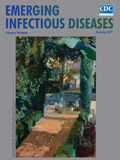
Volume 25, Number 11—November 2019
Letter
Macrolide-Resistant Mycoplasma genitalium in Southeastern Region of the Netherlands, 2014–2017
On This Page
Downloads
Article Metrics
To the Editor: We read with interest the article by Martens et al., which analyzed the frequency of macrolide resistance–mediating mutations in Mycoplasma genitalium infections in the southeastern region of the Netherlands during 2014–2017 (1). The authors reported high rates of macrolide resistance in M. genitalium infections (281/827; 34.0%) and observed a decrease in the rate in 2017 (115/290; 39.7%) compared with 2016 (92/207; 44.4%), after an increase in the number of tests of cure performed.
Increasing rates of macrolide resistance in M. genitalium are a problem not only in the Netherlands but also worldwide: 77.4% in New Zealand (2) and 41% in the United Kingdom (3). Macrolide resistance in M. genitalium as a consequence of single-dose azithromycin treatment has been previously reported (4). European Academy of Dermatology and Venereology guidelines recommend azithromycin in an extended regimen (500 mg day 1, 250 mg days 2–5, orally) as a first-line treatment, followed by a test of cure 4–6 weeks after treatment (5).
In northern Spain, local protocols for the treatment of M. genitalium infections are based on the European guideline. We performed a prospective/retrospective study during August 2015–October 2018. We confirmed 173 cases of M. genitalium infection; mean patient age was 29.4 years, and 57.2% (99/173) were male. We found macrolide-resistant M. genitalium strains in 21.8% (27/124) patients, which is a lower rate than was found in the Netherlands. Most of the patients attending posttreatment follow-up showed wild-type M. genitalium, and only 10.9% (5/46) became resistant to azithromycin treatment, in contrast with 89.6% (60/67) reported by Martens et al. We suggest that the decrease in macrolide resistance resulted from the increased number of posttreatment follow-ups. Our data confirm this. We believe that giving local advice on the basis of extended azithromycin treatment and posttreatment follow-up can limit the spread of macrolide resistance.
References
- Martens L, Kuster S, de Vos W, Kersten M, Berkhout H, Hagen F. Macrolide-resistant Mycoplasma genitalium in southeastern region of the Netherlands, 2014–2017. Emerg Infect Dis. 2019;25:1297–303.
- Anderson T, Coughlan E, Werno A. Mycoplasma genitalium macrolide and fluoroquinolone resistance detection and clinical implications in a selected cohort in New Zealand. J Clin Microbiol. 2017;55:3242–8.
- Pond MJ, Nori AV, Witney AA, Lopeman RC, Butcher PD, Sadiq ST. High prevalence of antibiotic-resistant Mycoplasma genitalium in nongonococcal urethritis: the need for routine testing and the inadequacy of current treatment options. Clin Infect Dis. 2014;58:631–7.
- Jensen JS, Bradshaw CS, Tabrizi SN, Fairley CK, Hamasuna R. Azithromycin treatment failure in Mycoplasma genitalium-positive patients with nongonococcal urethritis is associated with induced macrolide resistance. Clin Infect Dis. 2008;47:1546–53.
- Jensen JS, Cusini M, Gomberg M, Moi H. 2016 European guideline on Mycoplasma genitalium infections. J Eur Acad Dermatol Venereol. 2016;30:1650–6.
Original Publication Date: 8/22/2019






















.png)











No hay comentarios:
Publicar un comentario